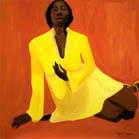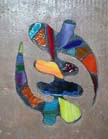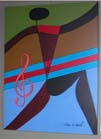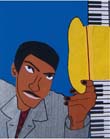By Virginia Small
The Sankofa Art Collective, one of the fastest growing and most dynamic art groups in the Denver Metro area, will be having their grand opening at the Back Do’ Studio at 3030 Downing St., March 17 and 18. The Friday night reception, from 6 to 10 p.m., will feature new art by members, a silent auction, and music by Ron Ivory. Saturday’s open house will continue the celebration with Master Drummer Jimmie Espirit and a community art experience. 
The Back Do’ Studio, a funky, warehouse/garage space, is located at the north corner of 3030 Downing St., at the end of the RTD Light Rail, in the heart of the historic Five Points District. Part of the Bo Matthews Center, the studio is adjacent to Tosh’s Hacienda.
The name Back Do’ is reminiscent of the times when African American people were only allowed to use the service entrances to homes and buildings. This limitation was not only for slaves and servants; it later included performers and musicians who were only allowed in the back entrances of clubs and theaters. It is also named Back Do’ because the entrance is around the corner from the main street.
The collective will offer classes, fundraisers, workshops, drumming, and many other events as well as the art show openings in the new studio. It is large enough to house already well-known events such as Kwanzaa.
The name Sankofa comes from the African Adinkra symbol of the Sankofa bird, looking back over its shoulder, which translates as "Go Back and Fetch It". This symbol means explore and understand your history to more consciously move into the future. This is what the Sankofa Arts Collective is about.
Just like the Sankofa bird, this new 2,500 square foot studio will be moving forward while looking back. To make it easier to find, a mural is being planned that will lead you to the entrance. The art will be hung on movable doors, following the theme of the gallery, so don’t expect to see the same gallery twice.
The idea for a collective was started in July 2003 by founder and Executive Director Marquis Price, who also helped start The Denver Black Arts Festival. “We wouldn’t have gotten so far, if it wasn’t supposed to be,” Price said.
Price noticed that Black artists would gather for the festival, but dissipate soon afterward. If an art collector wanted to find Black artists, there was no central place they could go. That’s when she got the idea for the collective. She sat down with artists Kef Parker, Dawn Williams Boyd, Helen Littlejohn, Randy McAnulty II, J.C. Tunson, Li Hardison, and Terri Nelson from the Blair Caldwell African American Resource Library. Together they formed Sankofa.
Nelson offered the library’s third floor gallery to Sankofa for monthly shows. The collective has had an exhibition at the library almost every month since then.
Through the Sankofa Arts Collective, African American artists have a way to meet each other in a culturally nurturing environment. As a group they are able to gain more visibility. Collectors no longer have a hard time finding the artists and art for which they are looking.
In the three short years since it began, the Collective has made enormous strides and is being recognized and sought out by many of the area’s prominent citizens. Businesses and organizations are seeking out the Collective for exhibitions. They have already participated in Kwanzaa events, conducted art demonstrations and workshops, created unique art for Project Angel Heart, and have participated in community fundraisers.
During Black History Month, Sankofa participated in at least four shows including the Iliff School of Theology. Work is also currently being shown at both Mocha Motive locations, 3030 Downing St. and 3401 Quebec St.
Sankofa is always looking for new members. African American artists are given the opportunity to showcase their art in a number of places in and around the Denver Metro area. Artists experience camaraderie and learn about professional practices. When a member/artist has a Sankofa sponsored show, post cards, publicity, and food for receptions are provided by the collective. Information on exhibition opportunities are shared at meetings and through e-mail. Classes and workshops are offered exclusively to members. They may have the opportunity to use part of the studio for a workspace. They can come to artists’ salons and create and talk about art in the home of a fellow artist. The collective meets weekly on Wednesday nights from 6 to 8 p.m. at 3030 Downing St. Meetings are open to the public and visitors are always welcome. You may also contact the group facilitators if you wish to make a presentation.
Meet some of the artists of Sankofa
Li Hardison is a native of New York who has lived in Denver for the past five years. She is an artist whose exquisite clay figures are turned into even more exquisite bronzes. Hardison never uses a prefix for her name when advertising her art. “Judgments are made about art whenever someone knows the race and sex of the artist,” she says. “I want my art to speak for itself.” Hardison was recently awarded a commission from the Denver Office of Cultural Affairs. The commission is for two bronze reliefs honoring Dr. Martin Luther King Jr. and will be displayed on planters along MLK Boulevard with a dedication this spring. She is also working on a pair of bronze newel post lights commissioned by a private citizen. The 17-inch high lamps are figures of a male and female, each holding a globe covered by reproductions of art nouveau glass shades. When finished, these figures will stand at the foot of a staircase.
Helen Littlejohn is a self-taught artist and poet who works in public relations in the field of education. After traveling the world as a child of military parents, her family settled in Denver where she graduated from Manual High School as valedictorian and attended the University of Denver on a Boettcher Scholarship. It wasn’t until the birth of her son James and his middle school art projects that she discovered her ability to create art. “The art speaks to me,” she said, “my challenge has been to learn how to listen.” Littlejohn works in acrylic, mixed media, and collage. She received the 2005 arts award from the Colorado Black Women for Political Action, and is a member of the Chicano Humanities & Arts Council and a board member of DU Art! One of her acrylic abstracts is on display at Denver’s Vance Kirkland Museum in the Colorado Collection. By a long shot, Littlejohn describes her artistic masterpiece as her son James.
Robert Aquarius paints on found objects such as trowels and frying pans. He made the arduous journey from New Orleans to Denver after his home was destroyed by Hurricane Katrina. He spent six days in the Superdome and spent 12 hours in line to get on a bus that was supposed to take him to Austin, Texas. He got off the bus in Houston to be reunited with his sister, but the bus left him. When he went back to New Orleans to see what was left of his home, he found everything destroyed except for his art.
|
|
“The city, which had been so vibrant, was like a ghost town,” he said. He brought his art back to Denver, but was distraught and lapsed into a depression. Not knowing anyone and unfamiliar with the environment, he “felt like an alien on a foreign planet.” Then, he picked up an Urban Spectrum and read the “Color Scope” segment which featured an article on the Sankofa Arts Collective. 
He made a beeline to the group and has been an active member ever since. “I was in my element,” surrounded by “bright hope, and out of my depression.”
Eddie Brown, a native of Denver with West Texas roots, comes from a family of artists and started drawing around age eight. Several factors drive him as an artist--a search for identity, and an inner drive to tell a story. “I believe that you must use your gifts or you will lose them. Artistic talent is a gift that must be shared,” said Brown. He studied art at the University of Northern Colorado and Denver Free University with Clarence Briscoe. His work is in several private collections in Colorado. Brown’s next artistic challenge is calling him to clay and woodworks.
Lesa Rose Webb was born in Los Angeles, Calif. and graduated from Santa Barbara City College with an Associate in Art degree. She works in a variety of mediums, including oil, acrylic, and watercolor paints. Her bold and graphic depictions have also been rendered in pencil, charcoal, and pastel. 
Mary Madison is a potter and textile artist. Her interest in pottery began as an outgrowth of sculpting original dolls in porcelain. Viewing the African pottery collection at the African American Museum deepened her interest in creating ceramic vessels. An earlier and ongoing interest in quilting and weaving has come together most recently in artwork that is a composite of these forms and surfaces. She calls her new work “Quilted Vessels.”
Virginia Small is a published writer, cartoonist, illustrator, and arts administrator. She works in colored pencil, as well as computer art. Small has been walking around with a pencil in her hand since the first grade. It often got her into trouble, in school and at home. No blank surface was safe. “People thought I wasn’t paying attention,” she said, “but I could listen better when I was sketching.” Her work is often based on fables, fairy tales, and goddesses. She considers herself a visual cultural worker and believes that art should tell a story. She earned her BFA from the School of Visual Arts in New York City and her MA from The University of Illinois. She also has a certificate in multimedia design.
Kef Parker is a native of Detroit whose whimsical, colorful, and complicated sculptures never fail to delight the eye and make observers laugh. This self-taught craftsperson considers his art gifts to “promote continual growth with family, community and self.” Parker explores his art through “cultural ties and ancestral roots.” This architect by trade makes and decorates his sculptures with found objects. 
Randy McAnulty II works in various media including painting, drawing oil, pastel, and found objects. A unifying thread in all of his pieces is bright color. “Color is the essence of my work. Contemporary color has an emotional appeal that combines with the composition and sets the stage for an experience of the senses.” Being in the Navy piqued McAnulty’s curiosity about the art and culture of other peoples.
Jack Price II was selected to do the CD cover The Best of 104.3 last December. He works in pastels, oils, inks, and acrylics. The subjects he chooses to depict are Native African, African American, and urban scenes. His art spans a range from such topics as the relationship between a grandparent and grandchild to the jazz scene. Price can be seen showing his work at many of the art festivals around Colorado.
Dawn A. Williams Boyd paints with cloth by means of quilting. Her work has been exhibited in Montana, Texas, New York, and or course, Colorado. She won a prestigious grant from the Rocky Mountain Women’s Institute and has also won an award from the CBWPA. Boyd also works in acrylic paint and Sculpy, but her most ambitious works are her large, colorful quilted illustrations. These quilts are not traditional repetitive designs; they are depictions of historical scenes and Black life. They are often embellished with elaborate beading and embroidery. “Quilting brings together all my artistic interests on a grand scale.”
Rochelle Johnson studied at the Rocky Mountain College of Art and Design and the Pratt Fine art Center in Seattle, Washington in 1997. It was there that she showed her work for the first time and was pleased when she sold a piece. “My objective as an artist is to portray emotions and energy in my work. You can say I'm a figurative artist, but I am not limited to that concept. To me, art is about gathering data and recording expressed events in an original way.” Johnson works primarily in oil paint. “Instead of focusing on line, and light and dark separation, I use shapes and watch how the shapes expose the human figure.”
Carrol Reeves is a lawyer with a BA in philosophy. She was taught by Hermon Futrell, a nationally known artist who has work in the Smithsonian. Her work takes form as out-of-the-ordinary cement sculptures. She calls her works “textured sculptures,” embellishing them with glass, tile, fabric, paper, seeds and beads. These pieces work beautifully in gardens and patios.
Deidre Hardin is an art teacher who inspires her children to always be at their creative best. She works in all types of craft media, including fabric, appliqué, Sculpy, beading, jewelry, and sculpture. Her sculptures often depict Black women caught in exuberant dance poses and dressed in colorful fabric.
Calendar (sidebar)
March
A group show in honor of Women’s History Month. Collective members will present art for/by/about women in Women’s Work, at the Blair Caldwell AARL.
April
Children of the Sun II, will feature Sankofa artists and children’s art from the community.
May
A group show by/for/about men.
July
Finding Common Ground, a joint show with the Chicano Humanities Arts Council at two locations, the CHAC Gallery at 772 Santa Fe and at Blair Caldwell AARL.
For more information write: Sankofa Arts Collective, P. O. Box 48052, Denver, Colorado 80204, call 303/394-4069 or 303/394-5190, or visit
SankofaArtsDenver@yahoo.com |
